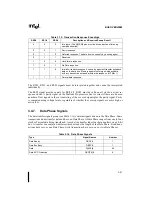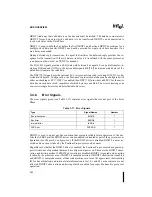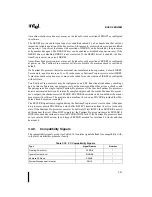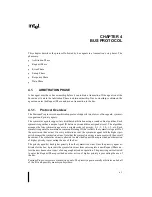
3-13
BUS OVERVIEW
3.4.3.
Request Signals
The request signals transfer request information, including the transaction address. A Request
Phase is two clocks long beginning with the assertion of ADS#, the Address Strobe signal, as
shown in Table 3-4.
The assertion of ADS# defines the beginning of the Request Phase. The REQa[4:0]# and
Aa[35:3]# signals are valid in the clock that ADS# is asserted. The REQb[4:0]#, ATTR[7:0]#,
DID[7:0], BE[7:0]#, and the EXF[4:0]# signals are all valid in the clock after ADS# is asserted.
RP# and AP[1:0]# are valid in both clocks of the Request Phase. The LOCK# signal from the
Arbitration Phase is asserted in the clock that ADS# is asserted for a bus locked operation.
The REQa[4:0]# and the REQb[4:0]# signals identify the transaction type as defined by Table
3-5. Note that partial memory read/write transactions can be locked on the bus by asserting
the LOCK# signal. Transactions are described in detail in Chapter 5, Bus Transactions and
Operations.
NOTES:
1. These signals are driven on the indicated pin during the first clock of the Request Phase (the clock in
which ADS# is driven asserted).
2. These signals are driven on the indicated pin during the second clock of the Request Phase (the clock
after ADS# is driven asserted).
Table 3-4. Request Signals
Pin Name
Pin Mnemonic
Signal Name
Signal Mnemonic
Number
Address Strobe
ADS#
Address Strobe
ADS#
1
Request Command
REQ[4:0]#
Request1
REQa[4:0]#
5
Extended Request2
REQb[4:0]#
Address
A[35:3]#
Address1
Aa[35:3]#
33
Debug (optional)2
Ab[35:32]#
Attributes2
ATTR[7:0]# or
Ab[31:24]#
Deferred ID2
DID[7:0]# or
Ab[23:16]#
Byte Enables2
BE[7:0]# or
Ab[15:8]#
Extended Functions2
EXF[4:0]# or
Ab[7:3]#
Address Parity
AP[1:0]#
Address Parity
AP[1:0]#
2
Request Parity
RP#
Request Parity
RP#
1
Summary of Contents for Pentium Pro Family
Page 17: ...1 Component Introduction ...
Page 26: ...2 Pentium Pro Processor Architecture Overview ...
Page 27: ......
Page 36: ...3 Bus Overview ...
Page 62: ...4 Bus Protocol ...
Page 105: ...5 Bus Transactions and Operations ...
Page 126: ...6 Range Registers ...
Page 131: ...7 Cache Protocol ...
Page 135: ...8 Data Integrity ...
Page 148: ...9 Configuration ...
Page 161: ...10 Pentium Pro Processor Test Access Port TAP ...
Page 172: ...11 Electrical Specifications ...
Page 201: ...12 GTL Interface Specification ...
Page 229: ...13 3 3V Tolerant Signal Quality Specifications ...
Page 233: ...14 Thermal Specifications ...
Page 239: ...15 Mechanical Specifications ...
Page 241: ...15 2 MECHANICAL SPECIFICATIONS s Figure 15 1 Package Dimensions Bottom View ...
Page 252: ...16 Tools ...
Page 260: ...16 8 TOOLS Figure 16 4 Generic MP System Layout for Debug Port Connection ...
Page 264: ...17 OverDrive Processor Socket Specification ...
Page 290: ...A Signals Reference ...
Page 320: ...Index ...
Page 328: ......
















































